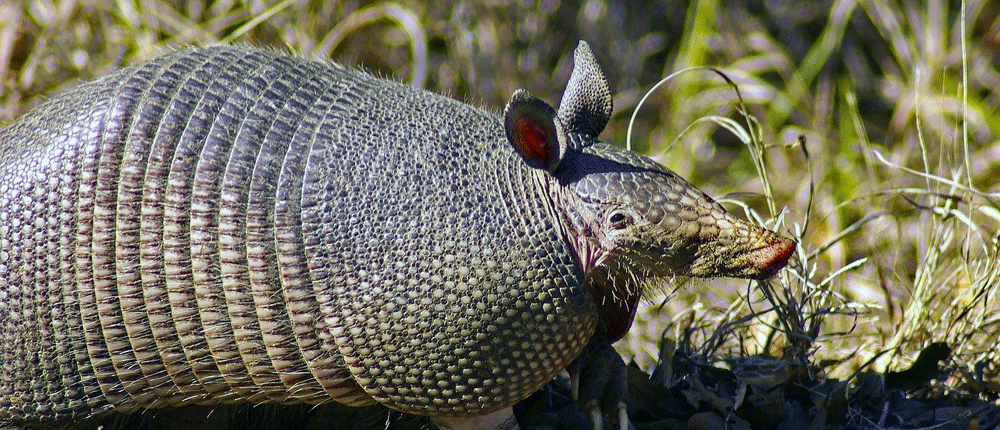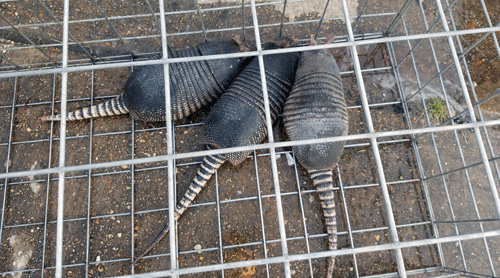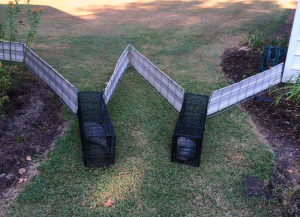How to get rid of Armadillos? (Humanely)
 Armadillos are rarely dangerous creatures. Although they may look somewhat menacing, it is not in an armadillo’s nature to attack humans. It’s important to remember this: the armor-like exterior that many people find menacing is actually made to protect him and not to injure you. Rarely do armadillos act strangely and aggressively, and in those cases, it is often the result of a rabies infection. If you suspect that you are dealing with a rabid armadillo, wait and call for a professional to get rid of it.
Armadillos are rarely dangerous creatures. Although they may look somewhat menacing, it is not in an armadillo’s nature to attack humans. It’s important to remember this: the armor-like exterior that many people find menacing is actually made to protect him and not to injure you. Rarely do armadillos act strangely and aggressively, and in those cases, it is often the result of a rabies infection. If you suspect that you are dealing with a rabid armadillo, wait and call for a professional to get rid of it.
Even though armadillos are not set to attack you, their digging habits can become quite destructive to you and your property. So if you think you may be dealing with armadillos, it’s good to get rid of them as quickly as possible.
In this guide, we will talk about how to get rid of an armadillo as humanely and as painlessly as possible.
1. First, make sure it is an armadillo you’re dealing with and not something else.
Since armadillos do most of their digging at night, you more than likely won’t catch them at it and have no way of knowing for sure that an armadillo is the culprit.
Armadillos generally dig around your yard in search of food or start digging next to and under your house for shelter.
They will dig holes in and around your lawn (max 3” deep) and have no qualms about uprooting shrubs and plants. They tend to burrow underneath taller structures, like shrubbery, maybe a tree, or even under the foundation of your house.
You are likely to find cracks in your foundation or even the sidewalk. These cracks appear because of an armadillo’s burrowing.
2. You want to make sure your yard isn’t armadillo friendly.
The next obvious step is to make your yard as unattractive as possible. Of course, you can’t do so completely because armadillos go for food that is underground, rather than above. Still, a good first step is to keep your yard clean of any fallen fruit or food, as these may attract the creatures (as well as other pests).
Another thing you can do to deter armadillos from approaching is to eliminate any burrowing places. Once again, an armadillo loves burrowing under cover and where he’s fairly hidden from view. So if you want to make sure an armadillo doesn’t wander into your yard and decide to make it their permanent hang-out, you’ll want to remove such burrowing spots. Shrubs, woodpiles, low-lying bushes – all need to go.

3. Consider your next steps
Many people rush toward trapping as their go-to pest removing solution, but we urge you to consider other options. First of all, you need to become familiar with your state laws and find out if trapping animals is legal for non-professionals in your area.
Second, if you do decide to attempt to trap an armadillo, please choose live trapping.
- Trapping
There are some really handy live traps on the market out there, so take your time picking out the best one. You can find traps with one door or even double door traps that encourage more suspicious animals to wander into it.You’ll want to place down the live trap at night, right as you’re going to bed because armadillos tend to be out in the dark and find it more comfortable to walk around your yard when the house is relatively quiet and they don’t risk detection.
You’ll want to place the live trap right at the entrance of the armadillo’s burrow or by the wall or fence where you suspect the armadillo’s been digging.
- Fencing
Many people shy away from fencing because they find it unappealing and unaesthetic, but the truth is, it’s one of the best ways to keep an armadillo away.Be careful when you’re choosing your fence, because you want to make sure it meets a few guidelines. Your fence needs to penetrate in the ground at least 15” deep. The shorter your fence is, the more likely it’ll be that the armadillo will dig under it, rendering it useless.
You also want to make sure your fence is around 25” tall and slightly curved at the top (toward the exterior, of course), so as to deter armadillos from getting over it.
Armadillos are wanderers by nature, but they do not tend to be aggressive. If they find a well-fenced property, they aren’t likely to bother making their way into it.
- Sprinkling
These things are also known as ‘electronic repellents’ and are an incredibly useful way to protect your property against armadillos. Electronic repellents are often placed strategically next to a vegetable patch, flowerbed or pathway. An electronic repellent is usually motion-activated and begins sprinkling water around when it detects movement. Armadillos are generally scared creatures and will run away if they get sprayed with water. - Repelling
There are other, non-electronic ways to repel an armadillo as well. Many people opt for castor oil repellents, because they’re widely available and easy to use. A castor repellent will penetrate the ground and spoil the armadillo’s food sources, like worms and insects.Castor oil will not only emit an unpleasant smell for the armadillo, but it will also make the ‘food’ taste bad, which will deter any armadillos from coming back.
If you don’t want to use castor oil, no worries, just keep in mind that an armadillo has a heightened sense of smell. There are certain scents an armadillo will not like, such as ammonia, mothballs, or vinegar. So, if your yard smells of any of these, an armadillo will keep away.
As we’ve seen, there are many ways to repel and deter armadillos from approaching your property. One thing you need to remember, however, is that armadillos can be a long-lasting problem. Even if you do get rid of the original armadillo that bothered you, others are likely to wander in because it’s in their nature. So you want to have a permanent armadillo-repelling system in place.
How to trap an armadillo
If you suspect you might be dealing with an armadillo, you might’ve had the idea to trap one. We are here to tell you how to do so safely and humanely.
We urge you to pay attention to the armadillo’s behavior, however. Armadillos are not generally creatures that freely approach people in the daylight or that behave aggressively. If an armadillo is doing any of these things, they may be rabid, and so, must be left for professionals to deal with, so as not to become infected.

- Choose your trap
Opt for a live trap, as we don’t want to actually hurt the armadillo in any way. There are plenty of traps available, but you’ll want one that is reasonably large and that will be a snug fit for the armadillo.
You can either go for a trap that has one or two doors. The ones with a single door are simple but may trigger armadillos’ suspicions since they might notice there isn’t a way out. Double door traps get rid of this problem and might improve your chances of catching the animal. - Place the trap
Your placement will be closely related to the type of damage you’re experiencing. Is the armadillo digging patches in your backyard in search of food? Or are they burrowing around your house in search of shelter?
It’s important to determine the animal’s path because armadillos tend to follow the same route and depend on their surroundings to guide them as they have poor eyesight. You want to place the trap along their route, which you can identify by the obvious marks in the ground.
Alternatively, you can choose to place the trap next to a nearby wall (close to the burrow) or right above the burrow entrance.
If all this is unavailable to you, you can place the trap close to the area the armadillo’s been digging up. - Set the trap
You’ll need to add some sort of bait inside the trap, an incentive for the animal to get in. if using a double door trap, make sure to place the bait in the middle, right between the two doors.
For bait, you’ll want something that armadillos are habitually attracted to, like worms. - Wait and check the trap frequently.
It’s cruel and inhumane to leave the armadillo trapped for hours on end, so make sure you check the trap as frequently as you can to see if you’ve caught it. Once you have, make sure to protect your arms, face and body as best you can when handling the trap. Since live traps have holes in them, an armadillo might lash out at you and claw you. And armadillo’s claws are known carriers of a variety of diseases. - Take your trap to another place.
You want to take it a good 5-10 miles to prevent it from coming back, and you’ll want to ensure you take it to a moist environment, such as a nearby stream or river. Once there, set the trap down, open it and wait for the armadillo to get out.
And that’s it, you’ve caught your armadillo!
How to keep armadillos from digging under my house, deck, or shed?

By nature, armadillos aren’t dangerous or aggressive creatures, so you don’t really need to worry about a potential attack. However, armadillos can cause considerable damage to your property by digging around your backyard and even trying to burrow around your foundation. Areas like the deck of your home or your shed are also at risk.
Many people wonder what steps they can take to prevent an armadillo from taking shelter around their yard or by their house.
First of all, if you suspect you’re dealing with an armadillo, you need to find it.
Armadillos aren’t generally people-friendly creatures and they tend to do most of their burrowing at night when there are fewer chances of being caught. So your best bet here would be to set some sort of live trap (a humane one that does not pose a threat to the creature) and wait for the armadillo to get caught.
Once you’ve caught and taken the armadillo to a different area, you want to locate their burrow and fill it up with gravel or dirt, to ensure other armadillos don’t come and claim it as their own.
After you’ve gotten rid of your resident armadillo, you’ll want to make your property as unattractive as possible.
There are many ways you can do this. A good idea is to fence your property. You’ll need to dig the fence in quite deep because armadillos have no trouble digging under shallow fences and finding their way into your backyard. But the effort is worth it because a well-dug fence will keep armadillos away.
You will also want to make sure that you don’t leave any potential food sources out that might attract an armadillo. Make sure your shed or the area around your house is food-free. This includes fallen fruits or anything that might be considered appetizing.
Remember that armadillos are very smell-oriented.
An armadillo’s eyesight is famously poor, and so it might not see any deterrents you place around your property. But an armadillo is highly sensitive to smells. It does not want to come close to strong smells, such as castor oil, ammonia, mothballs or vinegar. Pine needles and pine cones are also huge deterrents to these creatures, so make sure there are several ‘stinks’ around your property, to ensure its safety.
If dealing with armadillos in a shed, it’s actually better because it’ll be easier to keep the smell in and make it more powerful.
Check around your foundation and deck for any holes.
Even the ones that are not made by armadillos. These can attract armadillos and seem like a fun shelter for them, so you’ll want to fill in any such holes in and around your property.
Tip: You can use a mixture of dirt or gravel and mothballs, to heighten the bad smell. Don’t worry, it won’t be enough for humans to smell.
While there is no sure-fire way to keep armadillos from digging under or around your property, there are quite a few ways to discourage them from doing so.
How to keep armadillos off my yard or property?

Although armadillos aren’t particularly dangerous to people (unless they’re rabid), it’s still good to take precautions to keep them off your property. An armadillo will dig up your yard looking for food and try to burrow in your bushes or even under your house for shelter. So what can you do to keep armadillos off your property?
The most obvious answer is to buy a fence.
You’ll want a pretty deep fence, as armadillos are really good at digging, so if your fence is shallow, they’re quite likely to go straight under. Alternatively, you can wrap chicken wire around your yard or at least the areas of special importance, like a flowerbed or vegetable patch.
Get rid of what is attracting the armadillo in the first place.
Why are armadillos heading for human properties? Two reasons. They’re either trying to dig a shelter or looking for food and it’s important, if you want to get rid of the armadillo and keep it away, that you eliminate the food sources that are attracting the armadillo.
How can you do this?
First, you’ll want to make sure you don’t leave any exposed food like fruit on the ground in your yard or out on the deck. But that’s not enough and in order to properly keep armadillos away, you need to dig a little deeper, if you catch our drift.
See, armadillos are often attracted to worms and all sorts of insects that live in the earth, so cleaning up the exterior or the surface of your yard won’t do you much good.
Thankfully, there are ways of getting rid of the soil-dwelling food as well. You can purchase nematodes, specially sold for this purpose. These are parasitic worms that live off the armadillo’s food source and reduce it. And if there’s no food to attract it, chances are the armadillo will stay away.
Amp up on strong smells.
Armadillos have famously poor eyesight, so they’re not likely to be bothered by any visual deterrents. What this means for you, however, is that the armadillos rely on their sense of smell more heavily than other animals.
There are certain smells an armadillo simply does not enjoy, like vinegar, mothballs, ammonia, pine and other such strong odors. In fact, you can even fill little holes in the ground of your yard with mothballs to ensure the armadillo stays away.
Please keep in mind that armadillos are gentle and peaceful creatures. While they may look unsightly to you, they are not here to harm you or your family. In fact, the only armadillo that poses a direct threat to you is one infected with rabies. So unless absolutely necessary, do not attempt to harm the creature, as that is cruel and unnecessary. If you must trap it, handle it with care and don’t keep it caged for long. Take it somewhere far away, but don’t hurt it. It was only looking for food or shelter and not to hurt you.
